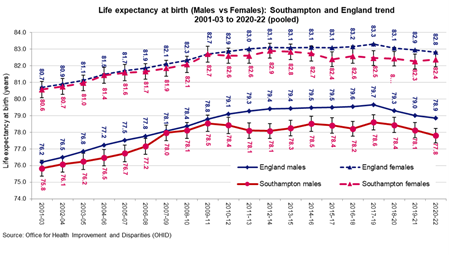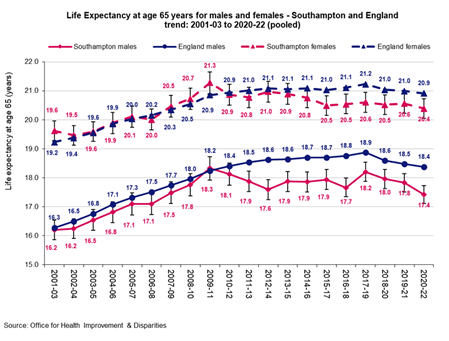
Life expectancy
 Life expectancy
Life expectancy
Life expectancy is a useful summary measure of the overall mortality and morbidity in a population.
There are different variations of life expectancy measures. The most used is life expectancy at a given age, often at birth or at age 65. This is the average number of years a person would live, if they experienced the area’s age-specific mortality rates for that time throughout their life. Figures reflect mortality among those living in an area in each time period, rather than what will be experienced throughout life among those born in the area. The figures are not therefore the number of years a baby born in the area could expect to live, both because the mortality rates of the area are likely to change in the future and because many of those born in the area will live elsewhere for at least some part of their lives.
Other variations include healthy life expectancy and disability-free life expectancy which try to consider quality of life in addition to quantity.
Benchmarking and trends data uses ONS Mid-Year Estimate population to calculate rates. For sub-city analysis, Small Area Population Forecasts (SAPF) from Hampshire County Council is used to calculate rates. Across these analyses averages for Southampton as whole will differ as a result. Also Ward and locality totals for the city values may not match deprivation quintile city totals due to the affect of 2023 electoral ward boundary changes.
Life expectancy at birth
Life expectancy at birth for males living in Southampton is currently estimated to be 77.8 years for the 2020-22 (pooled) period, significantly lower than the England average male life expectancy of 78.9 years and ranked 5th lowest among our ONS comparators. Male life expectancy had been decreasing in Southampton since the highest, recorded in 2017-19 (pooled) period, in line with the England trend. Between 2010-12 and 2016-18 (pooled) male life expectancy has plateaued around the 78 year mark, failing to keep in line with overall England increases.
Female life expectancy at birth is 82.4 years (2020-22 pooled), which is lower than the England average of 82.8 years. Since 2015-17 Southampton female life expectancy has been significantly lower than the England average. The gap between Southampton and England life expectancies was at its widest of 10 months for females in 2017-19 and 16 months for males in 2016-18 and since those periods the gap has been narrowing overall. For males and females, in Southampton and England life expectancy for 2018-20, 2019-21 and 2020-22 encompassing COVID-19 pandemic mortality, dipped compared to life expectancy for 2017-19. The chart shows the trend in life expectancy between 2001-03 and 2020-22 for males and females.
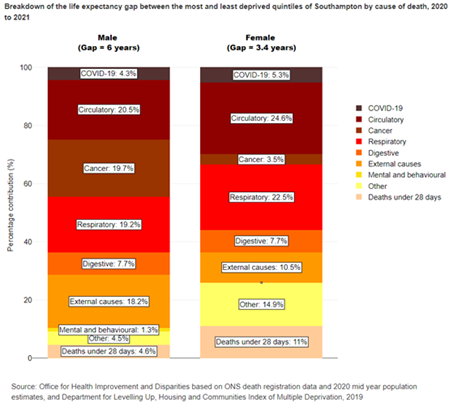 The Office for Health Improvement and Disparities (OHID) have produced an inequalities segment tool which shows the relative contribution that nine broad causes of death have on the gap between life expectancy for Southampton and that for England for the 2020 to 2021 period.
The Office for Health Improvement and Disparities (OHID) have produced an inequalities segment tool which shows the relative contribution that nine broad causes of death have on the gap between life expectancy for Southampton and that for England for the 2020 to 2021 period.
Circulatory disease (20.5%), cancer (19.7%) and respiratory (19.2%) deaths are the largest groups contributing to the gap in male life expectancy compared to England. On closer inspection, the two largest causes are chronic lower respiratory disease followed by heart disease. For females, circulatory disease (24.6%) is also the largest cause contributing to the gap in female life expectancy between Southampton and England, followed by respiratory diseases (22.5%), other causes (14.9%) and external causes (10.5%). Cancer deaths accounted for only 3.5% of the gap for females, in contrast to males where it was over 5 times higher. More detailed analysis shows the single largest cause of the gap in female life expectancy is chronic lower respiratory diseases followed by other causes and lung cancer. COVID-19 contributed 4.3% to the gap in male life expectancy and 5.3% to the gap in female life expectancy.
 In addition to the inequality gap between Southampton and England, there are statistically significant inequalities in life expectancy between neighbourhoods within the city. At a ward level, the latest data for the 2020-22 period shows that the ward Banister & Polygon has the lowest life expectancy for females at 80.8 years, whilst Bevois had the highest with 88.5 years (Bargate has been excluded due to small numbers for certain age bands affecting the reliability of the calculations). Thornhill has the lowest life expectancy for males at 76.0 years, whilst Bitterne Park has the highest at 81.6 years (again excluding Bargate).
In addition to the inequality gap between Southampton and England, there are statistically significant inequalities in life expectancy between neighbourhoods within the city. At a ward level, the latest data for the 2020-22 period shows that the ward Banister & Polygon has the lowest life expectancy for females at 80.8 years, whilst Bevois had the highest with 88.5 years (Bargate has been excluded due to small numbers for certain age bands affecting the reliability of the calculations). Thornhill has the lowest life expectancy for males at 76.0 years, whilst Bitterne Park has the highest at 81.6 years (again excluding Bargate).
When looking at the England deprivation quintiles for the 2020-22 period, males living in the 20% most deprived areas of the city live on average 5.3 years less than those living in the 20% least deprived areas. Females in the 20% most deprived areas live 3.9 years less than those in the 20% least deprived areas.
More information is available in the health inequalities section.
Life expectancy at 65
Life expectancy at 65 in Southampton mirrors the trends seen for life expectancy at birth for both males and females. Male life expectancy at 65 peaked at 18.3 years in 2009-11, slightly higher than the national average of 18.2 years. The England average rose to 18.9 years in 2017-19 however since has fallen to 18.4 years in 2020-22, most likely a factor of the pandemic. Southampton has fallen to 17.4 years, which is statistically significantly lower than England and the lowest it has been since 2007-09. Female life expectancy at 65 remains higher than their male counterparts at 20.4 years in 2020-22. This is a decrease from the 2009-11 (pooled) period where it peaked at 21.3 years. In comparison, life expectancy for England continued to increase, peaking in 2017-19 to 21.2 years and has since decreased to 20.9 years in 2020-22.
Similarly, to life expectancy at birth, small decreases in life expectancy at 65 years for males and females were seen in 2018-20, compared to 2017-19, the later period includes COVID-19 pandemic deaths. Since the 2001-03 (pooled) period, Southampton’s life expectancy at 65 has been consistently lower than the South East regional average as well as local neighbours, Hampshire and the Isle of Wight, for both males and females.
At a sub-city level for 2020-22, Peartree ward has the lowest male and female life expectancy at 65, at 16.2 years and 19.1 years respectively. The highest life expectancy at 65, for males, was recorded in Freemantle ward, 21.3 years, and Bevois for females, 28.1 years (excluding Bargate where due to small numbers for certain age bands, calculations are unreliable).
The life expectancy at 65 inequality gap, between those living in the 20% most deprived neighbourhoods in the city and those living in the 20% least deprived neighbourhoods (England deprivation quintiles), is 2.7 years for males and 2.6 years for females.
More information is available in the dashboard below and in the resources section.
Healthy life expectancy
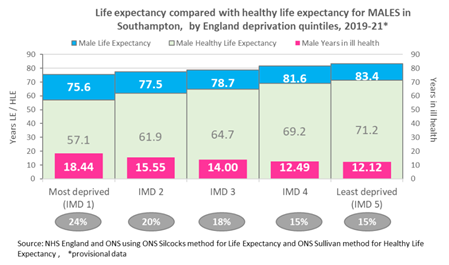 Healthy life expectancy (HLE) is an estimate of the number of years lived in good health (rather than with a disability or in poor health), based on mortality rates and prevalence of self-reported good health.
Healthy life expectancy (HLE) is an estimate of the number of years lived in good health (rather than with a disability or in poor health), based on mortality rates and prevalence of self-reported good health.
In 2018-20, in Southampton, healthy life expectancy for males was 61.4 years, which is lower than the national average of 63.1 years. For females, health life expectancy in Southampton is 63.1 years, which again is lower than the national average of 63.9 years. This suggests that in Southampton there is a wider healthy life expectancy gap (1.7 years) between males and females than that seen nationally (0.8 years).
Whilst healthy life expectancy nationally has remained relatively stable over the last decade, there has been more variation in Southampton, particularly for females. In 2018-20 (pooled) period, female healthy life expectancy increased to 63.1 years after dramatically falling to 59.8 years in 2016-2018.
At sub-city level in 2017-21, Thornhill has the lowest healthy life expectancy for males (60.1 years) and Bevois has the lowest healthy life expectancy at birth females (61.2 years), whilst Bassett has the highest HLE with 68.6 years for males and 70.4 years for females (excluding Bargate due to unreliability of small numbers for certain age bands in the calculations).
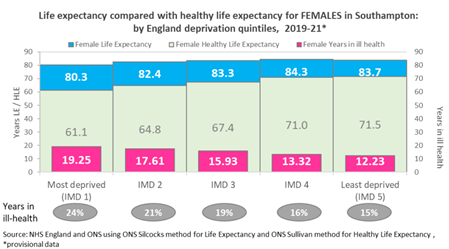 Health inequalities analysis includes comparing life expectancy and health life expectancy for males and females by deprivation quintile and assessing how many years people live in poorer health. Both males and females in the most deprived quintile live a quarter (24%) of their shorter lives in ill health. Males and females in the least deprived quintile live a seventh (15%) of their lives in ill health.
Health inequalities analysis includes comparing life expectancy and health life expectancy for males and females by deprivation quintile and assessing how many years people live in poorer health. Both males and females in the most deprived quintile live a quarter (24%) of their shorter lives in ill health. Males and females in the least deprived quintile live a seventh (15%) of their lives in ill health.
More information and data on healthy life expectancy can be found in the life expectancy and mortality dashboard below and in the resources section.
Disability-free life expectancy
 Disability-free life expectancy (DFLE) is an estimate of the number of years lived without a long-term physical or mental health condition that limits daily activities. In 2018-20, males in Southampton could expect to live 61.1 years disability-free, which is lower than the England average of 62.4 years, although not statistically significantly so. Despite females living longer than males, in Southampton and nationally, women live fewer years disability-free. In Southampton females have a disability-free life expectancy of 59.1 years, which is slightly lower than the England average of 60.9 years, although not statistically significantly so. Since 2014-2016, disability-free life expectancy of both males and females has decreased in Southampton at a quicker rate than nationally.
Disability-free life expectancy (DFLE) is an estimate of the number of years lived without a long-term physical or mental health condition that limits daily activities. In 2018-20, males in Southampton could expect to live 61.1 years disability-free, which is lower than the England average of 62.4 years, although not statistically significantly so. Despite females living longer than males, in Southampton and nationally, women live fewer years disability-free. In Southampton females have a disability-free life expectancy of 59.1 years, which is slightly lower than the England average of 60.9 years, although not statistically significantly so. Since 2014-2016, disability-free life expectancy of both males and females has decreased in Southampton at a quicker rate than nationally.
Disability-free life expectancy may differ from healthy life expectancy due to the self-reported nature of how the measures are calculated. For example, an individual may be disability-free but self-report that they are not in good health or vice versa.
More information can be found in the resources section below.
Resources
Life expectancy and mortality dashboard
The life expectancy and mortality dashboard present a range of data regarding life expectancy and mortality, to provide intelligence to help drive strategic decision making. Analysis includes benchmarking against statistical neighbours and trends over time for all indicators included. Some indicators include analysis at sub-city levels, by Southampton wards, primary care networks (PCNs) and deprivation quintiles.
OHID - Fingertip tools
Office for Health Improvement and Disparities (OHID) have produced several tools that allow for the exploration of life expectancy. The Fingertips tools produced by PHE bring together data on several indicators at local authority level and can be used to explore the data over time and between comparator areas. PHE have also produced an inequalities segment tool which provides information on the causes of death and age groups that are driving inequalities in life expectancy at local area level. Targeting the causes of death which contribute most to the life expectancy gap should have the biggest impact on reducing inequalities.
ONS – Life expectancy
The Office for National Statistics (ONS) have produced several reports, tools and datasets that investigate life expectancy and mortality in detail.
Last updated: 17 September 2024
